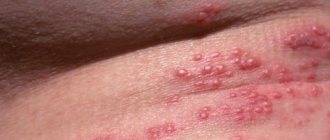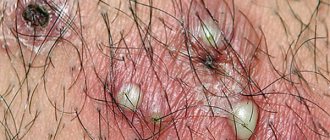Deep damage to the skin and mucous membranes of the genital organs can cause ulcers on the labia in women. The ulcers are usually painful, but sometimes cause no discomfort.
Such tissue defects can appear for various reasons. This could be a simple abrasion that appears as a result of unsuccessful hair removal in the groin, or some kind of disease. In any case, you need to consult a doctor.
Genital herpes
Inflammation of the female genital organs is often the result of STIs, but they can also be caused by skin diseases and other infections
Genital herpes is an infection that causes blisters or sores in the intimate area. This is the most common cause of inflammation in the genitals.
Tens of millions of people around the world are infected with genital herpes. In the United States alone, about 770 thousand new diseases are diagnosed annually. At the same time, the overwhelming majority (about 90%) of carriers of the herpes simplex virus (HSV-1 and HSV-2) do not experience symptoms, so the actual prevalence of the disease may be much more serious than official statistics indicate.
When a person has an outbreak of genital herpes, they develop one or more sores in the genital or anal area (anal herpes). They often do not cause much discomfort, but they can rupture and cause pain. If the ulcers rupture, they usually take 2 to 4 weeks to heal. The first outbreak of genital herpes usually causes symptoms to be more severe than subsequent ones.
If a person becomes infected with genital herpes, he will have this condition for the rest of his life. The disease is incurable, although outbreaks can be mitigated. There are medications that help reduce the frequency and duration of outbreaks.
Drugs belonging to the group of acyclic guanosine analogues reduce the duration of outbreaks. Most often, doctors prescribe acyclovir, valacyclovir and famciclovir in the form of tablets that must be taken for up to ten days.
People with genital herpes should avoid intimacy during outbreaks to prevent spreading the virus to sexual partners.
Ulcers on the penis with syphilitic ecthyma
Secondary syphilis can be severe.
One of them is syphilitic ecthyma.
It develops one and a half to two years from the onset of the disease.
With this course of syphilis, the formation of ulcers is observed.
Outwardly, they are similar to gumma ulcerations in tertiary syphilis.
Secondary syphilis with ecthyma is clinically severe.
The patient's temperature rises markedly and symptoms of general intoxication are observed.
The first symptom of syphilitic ecthyma is the appearance of red spots.
They cause severe pain.
Then the elements of ecthyma ulcerate, and in their place a pustule with purulent discharge is formed.
After drying, a crust forms on its surface.
There is a dark red infiltrative ridge around it.
The crust does not adhere tightly to the edges of the ulcer and is easily removed.
On the penis, syphilitic ecthyma develops relatively rarely.
Most often it affects the extremities, especially the legs.
Syphilis with the manifestation of syphilitic ecthyma is usually resistant to antibacterial therapy.
In addition, the presence of extensive ulcers contributes to the addition of a secondary infection.
This aggravates the patient's condition.
Molluscum contagiosum
Molluscum contagiosum is an infectious skin disease that causes small lesions or bumps on the thighs, buttocks, groin, or lower abdomen.
Lesions may appear in the genital area or around the anus. Sometimes they develop into large inflammations that cause itching and pain. Such inflammations can be flesh-colored, gray-white, yellow or pink. They are observed for two to four weeks.
In most cases, the lesions resolve naturally, although they sometimes recur. Doctors may remove the growths to prevent further spread of the infection.
Primary syphilis
Primary syphilis or Lues I is the first stage of the disease caused by a bacterium called Treponema pallidum. This is a sexually transmitted disease, known since ancient times, however, syphilis has not lost its significance today. The formation of ulcers on the skin and mucous membranes is a manifestation of primary syphilis, occurring approximately 5-6 weeks after contact with a sick person. Transmission occurs through biological fluids infected with treponema pallidum; much less frequently, transmission occurs through household means: through personal hygiene items.
Ulcer of the cervix
A syphilitic ulcer or chancre occurs at the site of penetration of the bacterium - on the skin or mucous membranes. This is a painless ulcer with dense edges ranging in size from a few millimeters to 4 centimeters in diameter. Primary syphilis is characterized by ulcers in the vagina, vulva, pubis of the inner thigh, and in the oral cavity. Chancre is completely painless and disappears on its own after 3-6 weeks. Unfortunately, with the disappearance of the ulcer, the disease does not stop, but only moves into the next stage. Secondary and tertiary syphilis appears.
Genital warts
Genital warts develop in about 1% of people with human papillomavirus (HPV). HPV is a common infection that in most cases does not cause visible lesions. Inflammations that occur as a result of the human papillomavirus usually do not cause harm and go away within a year.
Genital warts are soft and smooth growths, but they are firmly attached to those areas of the skin where there is hair. Their treatment depends on their location and size.
People with few warts can treat them with creams such as podophyllotoxin or imiquimod. Large warts are removed surgically.
Treatment of ulcers: effective antibiotics and when they are not needed
For bacterial infections, antibacterial drugs are the main method of treating the disease.
Therapy begins with broad-spectrum antibiotics.
This happens when its immediate onset is required and there is no time to determine the type of pathogen.
The doctor may replace the drug with one that is more relevant for a specific disease.
This depends on an accurate diagnosis and antibacterial tests.
Not all infections can be treated with antibiotics.
Such drugs are powerless for:
- non-infectious skin lesions;
- viral infections, such as herpes;
- fungal diseases.
For such diseases, specific treatment is necessary.
Viral infections require antiviral drugs and immune stimulation.
Fungal diseases are treated with antifungal agents.
Non-infectious lesions are treated depending on the exact cause of the disease.
Any means can be used both internally and externally.
For this purpose, ointments, creams, baths and lotions are used.
Most often, local treatment is auxiliary to general therapy.
Prevention
Safe sex with latex condoms is the best way to prevent genital lesions
Safe sex using barrier contraception is the only way to prevent STIs.
To avoid spreading the infection to sexual partners, people should avoid intimacy during outbreaks. If you have syphilis, you must avoid sex until the rash and inflammation go away completely.
Chancre
This is another sexually transmitted disease caused by bacteria from the genus Haemophilus influenzae. The process of infection with chancroid is similar to that of syphilis.
Chancroid
A soft chancre or ulcer is similar in appearance to a hard chancre, however, it has a number of differences:
- An ulcer forms about a week after sexual intercourse, initially appearing as a bright red spot.
- The ulcer has a soft edge and bottom.
- The chancre is painful and pus is discharged from it.
- The ulcer heals on its own in 2-3 weeks with the formation of a scar.
Other reasons
Although STIs are most often the cause of genital inflammation, the symptom in question can result from infections that are unrelated to sexual activity. It can also be caused by non-infectious diseases.
Behçet's disease
Behçet's disease often manifests as aphthous stomatitis. In the genital area, both single and multiple small inflammations occur. They are usually painful, have a gray or white coating and an erythematous rim.
Such inflammation can also be caused by other medical conditions, such as Crohn's disease. In addition, they can be provoked by hormonal fluctuations or vitamin deficiencies.
Before the lesions develop, people may experience flu-like symptoms as well as swelling in the genital area.
Most inflammations of this type go away on their own and heal within a few weeks. Doctors may suggest painkillers and, in more severe cases, steroids.
Contact dermatitis
Contact dermatitis occurs as a result of an allergic reaction to certain products, such as washing powders or detergents. Poisoning from nickel, poison ivy or perfume can also cause inflammation.
Avoiding the use of products that cause allergies is the best way to prevent and control contact dermatitis, but in particularly severe cases, doctors may prescribe treatment with steroids.
Phlebeurysm
Varicose veins may appear in the vulva or vaginal area. These veins usually cause slight discomfort, swelling, and a feeling of pressure in the affected area.
As a rule, varicose veins occur as the body ages or during pregnancy. If their development is associated with pregnancy, the bumps usually disappear within six weeks after birth without any treatment.
Cold compresses can relieve discomfort. In addition, physical activity that improves blood circulation, such as swimming, can help.
You can read more about varicose veins in the female genital area here.
Possible complications
If, even after the appearance of wounds on the surface of the genitals, a woman does not perform hygiene procedures, pathogenic microflora enters the resulting ulcers. In this case, a secondary infection develops and the inflammatory process progresses. Vulvitis is manifested by increased body temperature, severe pain in the genitals, swelling of the labia, and redness of the tissues. Due to intense discomfort, it is painful for a woman to urinate, walk, or sit.
Vulvitis is eliminated through antibacterial treatment, physiotherapeutic techniques, and application of compresses with anti-inflammatory drugs. Since the formation of ulcers on the labia is caused by viral and/or sexually transmitted diseases, secondary infertility may develop. This happens due to the lack of timely therapy.
Diagnostics
To determine the cause of inflammation on the genitals, the doctor may take a smear or perform a blood test.
Most causes of genital inflammation are easily treated. However, some conditions can lead to complications if left untreated. In very rare cases, lesions in the genital area become the result of cancer. And sometimes they are harmless cysts that can be removed surgically.
Since there are several causes of inflammation in the female genital organs, if such a symptom appears, you should consult a doctor as soon as possible, who will diagnose and offer optimal treatment.
The specialist will perform a physical examination to determine the cause of the inflammation. He or she may also recommend other tests, such as a blood test or a swab of the affected area.
Cancers
Such manifestations of cancer are typical for women during menopause against the background of atrophy of the vagina and vulva - kraurosis. Against the background of general dryness and thinning of the skin and mucous membranes of the genital organs, skin defects may appear in the form of painless ulcers and erosions that tend to grow deeper and wider. Most often we are talking about squamous cell skin cancer, less often – about other forms of oncology. Unfortunately, squamous cell carcinoma at the ulcer stage is an already advanced process that is not subject to radical treatment.
Prospects
In most cases, doctors can easily cure inflammation and ulcers on the genitals. For this purpose, antibiotics are prescribed, which can be used in the form of creams or tablets.
Some diseases, such as herpes, remain with a person for life and occur in outbreaks from time to time. You should go to the hospital if you experience a herpes outbreak for the first time.
Other medical conditions, such as contact dermatitis, may resolve without treatment. However, it is important to understand that in order to determine the correct therapeutic strategy, it is important to know the exact cause of the problem.
Which ulcers are not contagious?
Only ulcers due to non-communicable diseases are guaranteed not to threaten others.
This is the only category of ulcerations that are not dangerous to other people.
Such diseases include allergic reactions, dermatitis and dermatoses, injuries, and autoimmune diseases.
They are not contagious either through household or sexual contact.
It is important to remember that ulcerative elements can always be accompanied by a secondary infection.
Ulcers on the penis require the mandatory use of condoms for any type of sexual contact.











